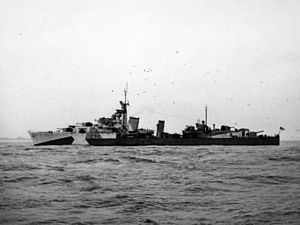Ordered 19 June 1936 Laid down 5 August 1936 Construction started 5 August 1936 Length 115 m | Namesake Eskimo Cost £342,108 Completed 30 December 1938 Launched 3 September 1937 Draft 3.43 m | |
 | ||
HMS Eskimo was a Tribal-class destroyer, laid down by the High Walker Yard of Vickers Armstrong at Newcastle-on-Tyne on 5 August 1936. She was launched on 3 September 1937 and commissioned on 30 December 1938. Eskimo served throughout the Second World War, seeing action in Norway, the Mediterranean, the English Channel and in Burma. After the war Eskimo was used as an accommodation and headquarters ship, finally being used as a practice target before being scrapped in 1949.
Contents
Operational history
Eskimo participated in the Second Battle of Narvik in April 1940. On 12 April Eskimo was hit by a torpedo fired from German destroyer Z2 Georg Thiele. The explosion caused severe damage, blowing off Eskimo's bow. After temporary repairs, by the shipwrights of the fleet repair ship Vindictive at Skjelfjorden in Norway, Eskimo was able to return to the Vickers Armstrong works at Newcastle for rebuilding.
She supported the Allied landings in North Africa in November 1942 and served with the 10th Destroyer Flotilla at Plymouth. Eskimo was extensively damaged when two German dive bombers attacked her in the Mediterranean while taking part in Operation Husky. She cornered and sank the enemy German submarine U-971 while in company with the Canadian destroyer Haida and a Liberator aircraft of the Czech air force in the English Channel north of Brest on 24 June 1944. During the final days of the war, she operated in the Far East.
Fate
Eskimo was reduced to an accommodation and headquarters ship for minesweepers, wreck-disposal vessels, and salvage craft clearing the Thames and Medway estuaries in 1946. She was used as a target ship in the Gareloch, sold for scrap on 27 June 1949 and finally broken up at Troon.
Museum holdings
Eskimo's bell is in the collection of the National Maritime Museum. Imperial War Museums holds a range of material relating to Eskimo, including photographs, film, and an officially commissioned watercolour by Vivian Pitchforth showing Eskimo refitting at Durban. The National Museum of the Royal Navy holds a detailed ship model of Eskimo, built by Commander John West. West had served in Eskimo as navigating officer at Narvik.
